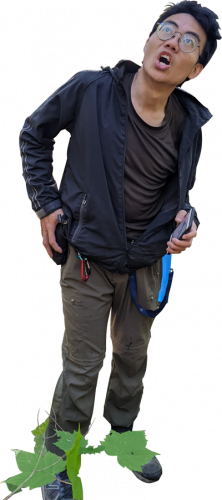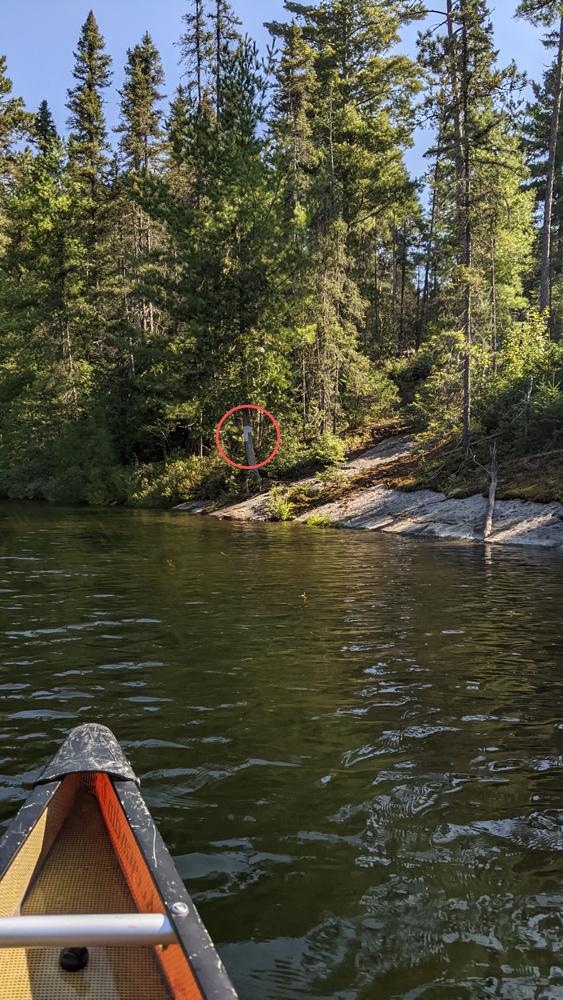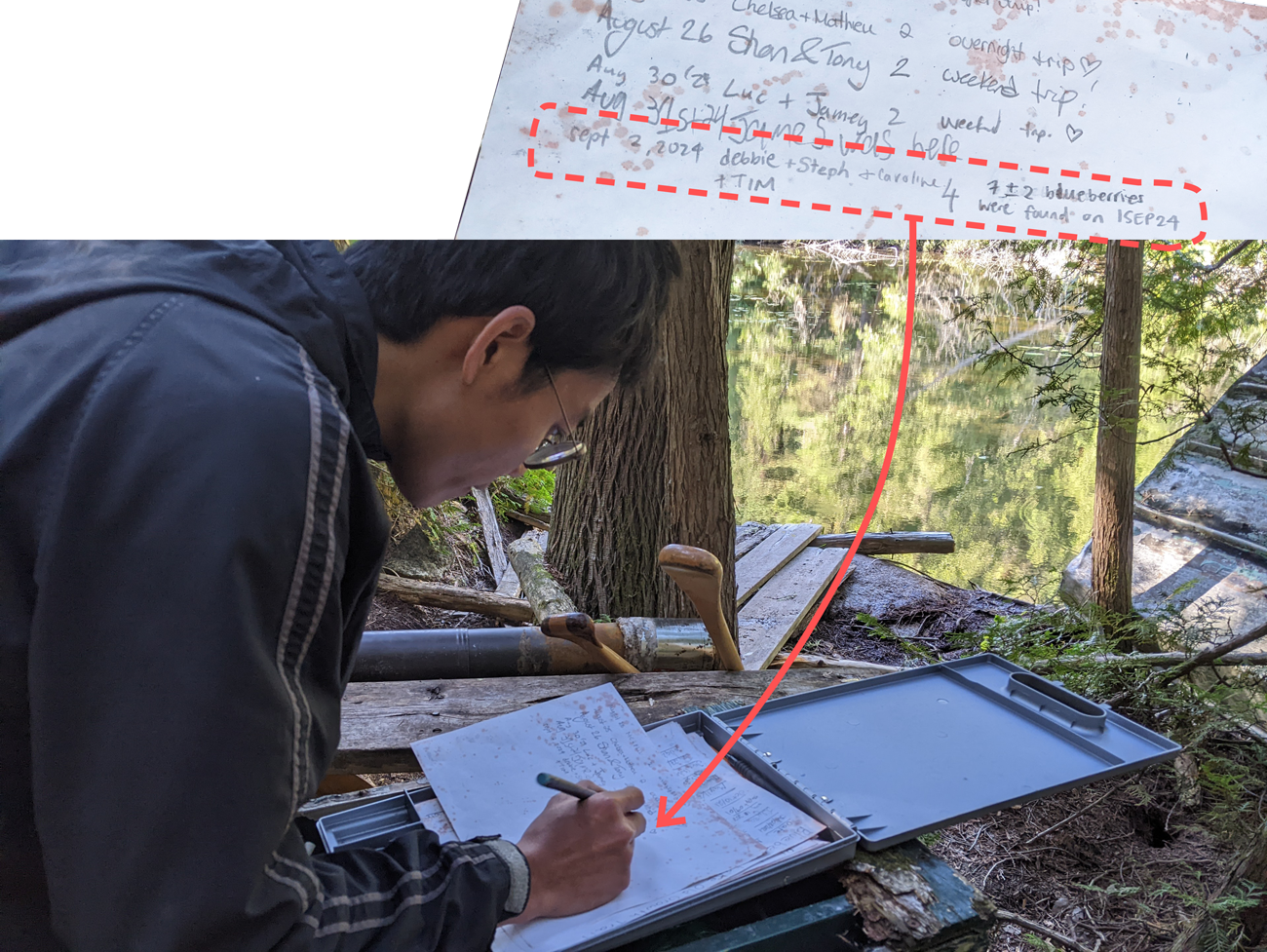Temagami 2024
“Temagami (Te-mee-ay-gaming , ‘deep water’ in Ojibway) lake and land around are the traditional territory of Algonquin people, homeland to Algonquins and Ojibways of Temagami First Nation. A territory of 4000 square miles has been a homeland for Original Peoples of Temagami for a long time before Contact with newcomers.“
Since hearing some aspirationally pro-campers swear by camping in Temagami, it has become a bucket-list camping destination for us. From naïvely attempting Crown land camping in 2021 (failing miserably and swearing never to go to Crown land again), to portaging through Algonquin’s Tim River in 2022, to backpacking through Killarney’s La Cloche Silhouette trail 2023, we finally felt prepared to tackle Temagami… we would be coming full circle from our newbie Crown land days!



The stars aligned when, napping at the UofT’s Earth Sciences Library one day, Tim discovered a book in the stacks featuring Ontario’s Old-Growth Forests, including some in Temagami!

✨ treasure-hunt-coded ✨
The introduction to the history through maps gave us just enough fodder to figure out where within the region we would hone in on. We ended up doing a loop from Cassels Lake to Rabbit Lake to Sunrise Lake to Blueberry Lake.
Day 1: Cassels Lake to Rabbit Lake
If there’s something you must know about Timothy, it’s that he is terrible at fishing. Over the past 5 years, he hasn’t caught a single fish in freshwater. Now, if at this point you thought, Hey, debbie, you haven’t caught any either, you wouldn’t be wrong… but I also believe there’s a very specific difference between my tendency to not go fishing, on one hand, and Tim’s tendency to go not-fishing, on the other. In fact, his buddies could only catch fish when they go without him. He even tried renting a boat in a lake recommended by successful fisherpeople, going at the buttcrack of dawn as recommended by successful fisherpeople, using bait recommended by successful fisherpeople. Not even a nibble in 8 hours. The fish hate Tim. It’s personal.
Now, imagine my skepticism when the lovely folks at Temagami Outfitting Company guaranteed that we would catch fish.
Just drop a line, they said. You’re bound to find a fish dumber than you are eventually, they said.
Challenge accepted. (<– me, sneering)
And so Tim set up his line at the back of the canoe while we were traveling to our first campsite. (The folks at Temagami Outfitting Company suggested he use his spinner as a lure).

This image on the left really ought to be hidden behind a spoiler alert for full impact, but while approaching the campsite he reeled in his line… ta-da! At the end of the line, a fish, cruelly dragged behind our canoe for God-knows-how-long.
We were quite nervous about finding campsites since we ended up going during Labour Day long weekend. If parks like Algonquin and Killarney required booking campsites five months in advance, what are the chances we can stumble on the few campsites on Crown land in a place as renown as Temagami that weren’t already occupied? Heck, Temagami’s old-growth forests are featured in a textbook. Nerds could be travelling far and wide for this! The only precaution we could take was to travel against the current (counterclockwise in this case) to avoid fellow nerds… but wouldn’t fellow nerds be thinking the same thing?? Augh!
Thankfully our fears that Temagami Crown land would be at full occupancy were far from realized (nerds, where u at?!). As highly regarded the forests are, we didn’t see other campers throughout the entire trip; perhaps this is why the fish here don’t need to outsmart Tim. On our first night, we didn’t just stay at just any campsite, we got to stay at the campsite featured in the aforementioned textbook that was positioned at the head of the old-growth trail we planned to hike the next morning. Maybe Ontario’s Old-Growth Forests Second Edition simply isn’t *that* popular 😂.

As for the trail… I’ll let the book speak for itself:
“A large area of white and red pine forest that is over two hundred years old and rarely visited, this forest is one of Temagami’s hidden gems. The drawback is that the only access to the forest is a disused portage trail, which starts of in mediocre condition and becomes progressively worse.”
— Ontario’s Old-Growth Forests Second Edition
We (read: Tim) tried our best to follow the trail (read: orienteer) using the purported path on the textbook and a compass, but the trail was as poorly maintained as warned, and we found ourselves literally bushwhacking through dense forest.

I have all these vain ideas of being someone who resists being told what to do, hates going where others have gone; and sometimes–as gross as this is to admit–I may even smugly consider myself a ~*free thinker*~… Nuh uh, all such self-indulgences are relinquished in the presence of an hiking trail: tell me exactly what to do, take me where every other sucker has gone, how dare you make me use my brain!


Day 2: Cassels Lake to Sunrise Lake to Blueberry Lake

Portages on Crown land are no joke. The paths, when present, were every combination of tripping hazards: slippery, muddy, rocky, mossy tree roots. The safest places to land my feet would be incompatible with the safest places to hold a canoe in the x-dimension; sharp turns that didn’t fit the turning radius of a canoe with it’s long y-dimension; fallen trees created roadblocks both above and below in the z-dimension.
Inconsistent (and nonexistent) labeling made wayfinding difficult at times, to say the least. At points (specifically between Sunrise Lake and Blueberry Lake!), neither our digital maps nor Jeff’s Maps showed the trail well enough to indicate where one could expect even the most macho of dudes to carry a canoe through. In a last ditch effort, we analyzed a photo of a photo of a map printed in Ontario’s Old-Growth Forests Second Edition which showed us that the portage continued past an unnamed puddle/lake. Bless the authors of Ontario’s Old-Growth Forests Second Edition ♡ ╰(ಥ ᗜ ಥ)╯♡.


Day 2-3: Blueberry Lake


For the first time in three years that we had the luxury of staying at the same campsite for two nights in a row! This campsite also had all the amenities: an excellent view over a cliff, benches, two spacious and flat “bedrooms”, a fully stocked kitchen (salt, pepper, a saw, tongs, firepit forks, so many blueberry bushes), clothes line, so many rocks to nap on, and a 5-star thunderbox.
Stargazing was also next level. Resting on rocks next to the lake put us at a perfect incline to see the stars facing north. We saw some shooting stars, and even the pale-est aurora of life next to the Milky Way. It’s still aurora nonetheless, so you bet I’m gonna commit it to memory, paint it, and use it as a flex for the rest of my life.

Just as we thought we’d seen everything, we saw what looked like a reverse-firework. From the top of our vision straight towards horizon, we saw a bright streak ending in a brief explosion of colour and something breaking into pieces. There was no sound associated with it; it was far too quiet to be an explosion/firework.
We think what we saw was more interesting than a typical meteor, not newsworthy enough to be a bolide meteor, and we can’t possibly be special enough to have witnessed secret weapons testing or aliens in a casual half-hour stargazing stint. A fireball meteor seemed to fit the description best. I submitted a report on amsmeteors.org and it seems to have coincided with some other sightings! While we’re not special enough to have witnessed something conspiratorial, extraterrestrial, or newsworthy, it’s apparently rare enough to be a once-in-a-lifetime sighting. I guess what I’m saying is, I’m ready to die now.

I tried to paint what I saw, but I think that scene in Howl’s Moving Castle where Howl meets Calcifer is the closest approximation.
Blueberry Lake features several trails through old-growth white and red pine forest. These were so much better marked and maintained than the previously attempted Rabbit Lake “trail”. They quite educational and we were able to enjoy them all to ourselves.


After the hikes, we enjoyed a less structured exploration of Blueberry Lake.
→ Tim found another fish dumber than he! It’s not a fluke, the fish here really are dumber 😉
↓ Staying true to its name, Blueberry Lake had so many blueberry plants that we collectively found 7±2 blueberries enough though it was some 2 standard deviations past peak blueberry season!


Three Parting Thoughts
1 – Our camping trips are usually something I ultimately agree to begrudgingly, partially for the sake of social cohesion, but (let’s be real) mostly as part of the periodic upkeep I require of myself to maintain my self-image as an adequately hardcore individual. However, now that we’ve strategically upgraded our gear, identified principles of effective food preparation, and generally removed most points of friction, the camping experience is no longer something I just want to get through to maintain my questionable sense of self-esteem, but finally an experience I can actually enjoy in the moment.

I still can’t believe I was lackadaisically taking dumps in an old-growth forest
Annual trip poem/song by Dr. Steph:
We friends have returned
To where it began.
We’re a bit further north,
But we’re back on Crown land.
We’re now seasoned campers,
We have Silhouette patches.
Tim outsmarts the fish,
For largemouth bass catches.
Our arms tire from paddling,
Not from carrying wood.
Caroline steers us straight,
No spinning is good.
We bushwack through forests.
Debbie canoes in her sleep.
Our meals are more practical,
Bring just what we eat.
We’ve leveled up gear,
Improved the camp situation.
Steph in front, Caroline back for best,
Canoe-carry permutation.
We wander by old growth,
Red and white pines.
We keep some traditions,
A lunch rock for good times.
At night we discover,
Many new sights.
A multicoloured fireball,
Shooting stars, northern lights.
We see blueberry sunsets,
Loons and vultures too.
It’s a more chill adventure,
Ending with Zoltan’s BBQ!


2 – This Crown land trip was also different from our first foray thanks to the care that Friends of Temagami took to maintain it. Having was no unifying standard for infrastructure or iconography that a National/Provincial Park would, gave room to discover the volunteers’ relationships to the place through little expressions of their individual personalities and humour here and there.
Admittedly, I only started taking interest in the what Ontario’s Old-Growth Forests Second Edition had to say about Temagami after spending time in it (in contrast, Tim had already read the entire book cover-to-cover prior to the trip). In doing so, I learned that, even before Friends of Temagami was formed, residents, Indigenous peoples, and environmentalists fought hard for the protection of the old-growth forest here. My enjoyment of the place is also a witness to the efforts these folks made.
“Most of the old-growth white and red pine forests, with trees that were commonly two hundred to four hundred years old, were logged in just five decades. … The single most intense battle, which changed the way old-growth was viewed across the province, was fought over the proposed logging of the Obabika Lake old-growth pine stand. This protest resulted in 344 arrests of protesters blockading the Red Squirrel Logging Rd. in 1989. … Ultimately, about half of Temagami’s remaining old-growth forest was protected.”
— Ontario’s Old-Growth Forests Second Edition

3 – On the way home, we were stuck in a typical long weekend traffic jam. The reason for this particular traffic jam was horrifying: a collision between a car and a moose. It’s an image I knew I had to commit to memory and document, lest I forget that these tragedies come part and parcel with our forest tourism (voyeurism?).
